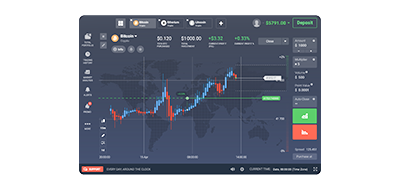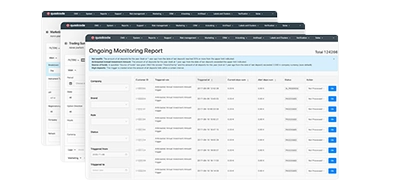Voltar
Contents
O que é o indicador SAR Parabólico?

Iva Kalatozishvili
Business Development Manager

Demetris Makrides
Senior Business Development Manager
O indicador Parabolic Stop and Reverse é uma ferramenta popular entre traders para determinar a direção do movimento do preço de um ativo e detectar prováveis reversões de mercado. O PSAR avalia a tendência atual para ajudar os traders a decidir se devem ou não entrar no mercado. Essa análise é exibida em um gráfico como uma sequência de pontos acima ou abaixo das barras do candle.
Definição e Fórmula
Como o SAR parabólico é calculado e exibido em um gráfico? Usando uma fórmula, o indicador PSAR cria uma curva parabólica em um gráfico de preços que se ajusta para refletir as variações de preço. O indicador é mais sensível às variações de preço ao longo do tempo, utilizando um fator de aceleração (FA) que aumenta progressivamente à medida que a tendência avança. A fórmula principal é a seguinte:
Para uma tendência de alta:
PSAR = SAR anterior + AF anterior x (EP anterior - PSAR anterior)
Para uma tendência de baixa:
PSAR = SAR anterior - AF anterior x (PSAR anterior - EP anterior)
Onde:
- Procurar: Valor de Parar e Reverter.
- AF: Fator de aceleração, começando em 0,02 e aumentando em 0,02 a cada novo ponto extremo. O valor máximo vai até 0,20.
- EP: Ponto extremo, a máxima mais alta durante uma tendência de alta ou a mínima mais baixa durante uma tendência de baixa.
- Procurar: Valor de Parar e Reverter.
- AF: Fator de aceleração, começando em 0,02 e aumentando em 0,02 a cada novo ponto extremo. O valor máximo vai até 0,20.
- EP: Ponto extremo, a máxima mais alta durante uma tendência de alta ou a mínima mais baixa durante uma tendência de baixa.
Esta fórmula produz uma curva que reflete a tendência do preço. Quando o preço cruza o nível do SAR, isso indica uma possível reversão, incentivando os traders a considerarem a mudança de posições compradas para vendidas ou vice-versa.
Qual é a precisão do SAR parabólico?
A precisão do SAR Parabólico é amplamente determinada pelas circunstâncias do mercado. Ele funciona especialmente bem em mercados com tendências, quando os preços se movem consistentemente em uma direção. Nesses casos, o SAR Parabólico pode oferecer indicações oportunas para iniciar ou abandonar negociações, permitindo que os traders capitalizem a tendência com sucesso.
Por outro lado, o SAR Parabólico pode fornecer indicações errôneas em mercados de variação ou lateral, com movimentos de preços irregulares e sem uma direção clara. O cruzamento frequente de preços acima do SAR pode causar "chicotes", forçando os traders a comprar e encerrar posições prematuramente. Isso ocorre porque o indicador se destina a rastrear tendências e pode ser enganado pela volatilidade de curto prazo.
Como usar o SAR Parabólico?
O SAR Parabólico é um indicador técnico que pode ser usado para criar ordens stop-loss dinâmicas, detectar direções de tendências e selecionar os melhores locais de entrada e saída. Os traders interpretam os pontos do SAR como barras de preço em um gráfico. Quando os pontos do SAR caem abaixo das barras de preço, isso indica uma tendência de alta com momentum positivo, o que significa que os traders podem optar por manter ou iniciar posições compradas, já que a projeção é de que os preços continuem subindo. Por outro lado, uma atitude negativa e uma tendência de queda são indicadas quando os pontos do SAR abrangem as barras de preço. Isso sugere que os preços podem cair e que os traders podem considerar sair de operações compradas existentes ou entrar em posições vendidas.
O timing de entradas e saídas pode ser melhorado pela observação das variações nos pontos do SAR. No entanto, apesar de o SAR Parabólico gerar sinais oportunos, ele não deve ser usado isoladamente. Circunstâncias de mercado, como volatilidade e força de tendência, podem influenciar a confiabilidade do sinal, portanto, análises mais aprofundadas do mercado são necessárias para aprimorar a tomada de decisões.
O SAR Parabólico também ajuda a fornecer ordens de stop-loss dinâmicas que acompanham o movimento dos preços, permitindo uma melhor gestão de risco. Os traders podem garantir ganhos com a alta positiva do preço, ao mesmo tempo que limitam possíveis perdas em caso de reversão do mercado, ajustando seus níveis de stop-loss ao valor atual do SAR conforme a tendência se desenvolve. Em uma tendência de alta, por exemplo, um trader pode definir seu stop-loss imediatamente abaixo do ponto de SAR mais recente e modificá-lo para cima conforme o preço sobe. Essa estratégia garante que a ordem de stop-loss siga a tendência do mercado, proporcionando uma abordagem organizada para proteger os lucros sem a necessidade de ajustes manuais frequentes por parte do trader.
Qual é o melhor valor para SAR parabólico?
Nas circunstâncias padrão, o fator de aceleração inicial do SAR Parabólico é 0,02. Esse fator aumenta em 0,02 a cada ponto extremo adicional, atingindo um máximo de 0,20. Mesmo que essas configurações sejam consideradas convencionais, é possível que não sejam as mais eficazes para todos os cenários de negociação em potencial. Usar um AF menor, como 0,01, pode diminuir a sensibilidade do indicador a movimentos de preços, o que pode ajudar a mitigar sinais falsos em mercados com alta volatilidade. No entanto, pode atrasar a reação a reversões de tendência reais, resultando potencialmente em oportunidades perdidas. Por outro lado, o SAR Parabólico se torna mais responsivo quando o AF é aumentado para 0,03 ou mais, resultando na geração de sinais para entradas e saídas que são gerados mais rapidamente. Essa sensibilidade elevada é vantajosa em mercados com tendências fortes; no entanto, pode resultar em um número maior de sinais falsos em mercados com ações de preço frequentes.
Fatores como a volatilidade do ativo, os prazos de negociação e a capacidade de risco individual são determinantes para estabelecer o valor ideal de AF. Swing traders que mantêm posições por um longo período podem escolher um AF menor para eliminar o ruído do mercado, enquanto day traders que se concentram em flutuações de curto prazo podem preferir um AF maior para maior sensibilidade. Para determinar os parâmetros ideais, os traders devem testar diferentes valores de AF em relação a dados históricos para verificar o desempenho do indicador em diferentes cenários. A eficácia do SAR Parabólico na identificação de tendências e na tomada de decisões informadas pode ser aprimorada por traders que personalizam o fator de aceleração para corresponder a ativos e condições de mercado específicos.
O SAR Parabólico é lucrativo?
A rentabilidade do SAR Parabólico é significativamente influenciada por sua integração a uma estratégia de negociação abrangente. Os traders podem capturar efetivamente movimentos de preço significativos utilizando o SAR Parabólico, que fornece sinais distintos de entrada e saída em mercados com tendências fortes e sustentadas. Sua capacidade de criar níveis de stop-loss contínuos ajuda a gerenciar riscos e proteger ganhos, modificando o stop-loss em resposta à tendência atual. Novamente, a importância de um mercado em tendência deve ser destacada neste caso.
No entanto, em mercados sem tendências direcionais aparentes, a proficiência do indicador diminui devido a sinais enganosos de reversões frequentes e pequenas variações. Confiar inteiramente no SAR Parabólico nessas situações pode resultar em perdas. Para aumentar a lucratividade, utilize o SAR Parabólico com outros indicadores técnicos para confirmar os sinais e reduzir falsos positivos. Além disso, compreender o contexto mais amplo do mercado e aplicar bons processos de gestão de risco, como o tamanho adequado da posição e métodos disciplinados de stop-loss e take-profit, são cruciais para o sucesso a longo prazo ao utilizar o SAR Parabólico.
Prós e contras
O SAR Parabólico está se tornando cada vez mais popular entre os traders devido aos seus diversos benefícios. Um de seus principais méritos é a simplicidade e a facilidade de uso. A representação visual da indicação nos gráficos de preços, com pontos aparecendo acima ou abaixo das barras de preço, fornece insights instantâneos e claros sobre a direção da tendência do mercado e os prováveis pontos de reversão. Ele está facilmente disponível para traders de todos os níveis de experiência, incluindo iniciantes, que podem ter dificuldade em interpretar indicadores complexos. Sua natureza simples permite que os traders o incluam facilmente em suas pesquisas sem a necessidade de treinamento substancial.
A flexibilidade do indicador em múltiplos períodos e mercados acrescenta ainda outra vantagem. Com o uso do PSAR, é possível negociar com sucesso commodities, moedas, ações ou criptomoedas. Os traders podem adaptar o indicador aos seus próprios objetivos e métodos, graças à sua adaptabilidade a uma ampla variedade de técnicas de negociação, incluindo swing trading, day trading e investimentos de longo prazo, entre outras.
Além disso, como mencionado anteriormente, o SAR Parabólico melhora a gestão de risco ao definir níveis dinâmicos de stop-loss. À medida que o preço se move a favor de uma transação, os pontos do SAR acompanham o preço, oferecendo assim uma abordagem sistemática para o ajuste de ordens de stop-loss. Essa função de trailing stop protege os lucros e, ao mesmo tempo, adiciona disciplina às estratégias de negociação, promovendo a adesão a estratégias de saída predefinidas em vez de decisões emocionais.
O SAR Parabólico, no entanto, tem suas desvantagens. Uma desvantagem notável é a sua eficácia em mercados turbulentos ou com tendência lateral. Sinais frequentes e pouco confiáveis podem ser gerados pelo indicador durante períodos em que não há tendência direcional significativa. Os pontos do SAR podem se mover rapidamente acima e abaixo das barras de preço devido à flutuação do preço em torno de um nível específico. Os traders podem experimentar oscilações bruscas, resultando em custos de transação e potenciais perdas sem ganhos substanciais.
A sensibilidade do SAR Parabólico também pode resultar em sinais falsos durante períodos de alta volatilidade. O indicador pode indicar uma reversão de tendência que não ocorre e pode levar a saídas ou entradas prematuras devido a picos ou quedas repentinas de preços. Ajustar o fator de aceleração pode ajudar a reduzir esse problema, mas encontrar a melhor opção requer consideração cuidadosa e pode mudar dependendo do ativo e das circunstâncias do mercado.
Outra desvantagem do SAR Parabólico é que ele não considera os fatores fundamentais que influenciam o mercado. Este indicador é de natureza exclusivamente técnica, pois depende de dados históricos de preços e desconsidera dados econômicos, desempenho de empresas, desenvolvimentos políticos e outros fatores fundamentais que podem ter um impacto substancial nos preços dos ativos. Informações críticas que podem influenciar as decisões de negociação dos traders podem ser ignoradas por aqueles que dependem exclusivamente do SAR Parabólico. Portanto, não é recomendável utilizá-lo isoladamente.
Além disso, por ser um indicador de trailing, o SAR Parabólico pode reagir após grandes movimentos de preço. Essa latência pode fazer com que os traders percam os pontos de entrada ou saída mais vantajosos, principalmente em mercados que mudam rapidamente e apresentam flutuações de preço rápidas.
A necessidade de modificações frequentes também deve ser levada em consideração. Os melhores parâmetros do SAR Parabólico variam substancialmente com base no ativo, nas circunstâncias do mercado e no período considerado. Os traders podem precisar ajustar constantemente os valores de AG e do passo máximo para manter o indicador eficaz, o que pode ser demorado e requer um profundo entendimento de como esses fatores afetam seu desempenho.
O Parabolic SAR é bom para scalping?
O SAR Parabólico é adequado para scalping devido à sua capacidade de detectar mudanças de tendência de curto prazo, oferecendo sinais rápidos de entrada e saída que correspondem à tomada de decisão ágil necessária neste método de negociação. Quando configurado com níveis de sensibilidade mais altos, o indicador reage rapidamente às flutuações de preço, auxiliando os traders a identificar microtendências dentro da ação de preço intradiária. Scalpers podem aproveitar oportunidades de negociação de curta duração que, de outra forma, passariam despercebidas com indicadores menos sensíveis.
No entanto, a maior sensibilidade necessária para o scalping pode resultar em um maior número de sinais falsos, especialmente em mercados extremamente voláteis. Variações frequentes de preço podem levar o indicador a alternar rapidamente entre sinais de compra e venda. Isso pode aumentar os custos de transação e possíveis perdas, reduzindo a lucratividade. Para resolver esses problemas, considere combinar o SAR Parabólico com outros indicadores técnicos de curto prazo, como osciladores estocásticos ou Bandas de Bollinger, para fornecer confirmação adicional e melhorar a confiabilidade das opções de negociação.
Conclusão
O SAR Parabólico é um indicador simples, porém poderoso, que pode identificar tendências de mercado e prováveis pontos de reversão. É um método de negociação popular devido aos seus sinais visuais simples e tem a capacidade de melhorar a tomada de decisões e o desempenho das negociações quando combinado com outras ferramentas analíticas como parte de uma estratégia de negociação mais ampla. Para usar este indicador com sucesso, os traders devem entender seus limites e ajustar suas configurações com base nas circunstâncias do mercado.
Atualizado:
19 de dezembro de 2024




